So, you’re thinking about getting an aquarium – we get it. Aquariums are an interesting addition to any space. Plus, fish, shrimp, snails, and other inhabitants make low-maintenance pets that can provide hours of visual stimulation.
When it comes to selecting your new pets, where do you start?
If your dream is a community fish tank containing multiple species of fish swimming in harmony, it’s important to realize that any combination of fish cannot simply be thrown in a tank together and expected to coexist.
We’re going to take you through the best colorful freshwater fish combinations that you can keep in the same aquarium.
It’s important to remember that not all fish are compatible and you certainly need to do your research if you care about the well-being of your fish and. you know, keeping them from killing each other.
A Few Things to Know About Aquariums
While this article focuses on which colorful freshwater fish you can successfully mix together, it’s important to spend some time researching aquariums as well.
Getting the setup right is more than half the battle when it comes to making sure your fish live their best life. As always, you should consult with a professional before making any major purchase.
Start by informing them of exactly what you’re looking for. This comes down to everything from the literal space you have to put a fish tank to how many fish you’d like to keep.
Here are some factors to take note of when purchasing your first aquarium:
- Consider what you can While the aquarium alone may not break your budget, there are plenty of accessories that you need to go along with it – including the fish itself!
- What size fish tank are you looking for? Each fish has a minimum requirement when it comes to how many gallons of water it needs to thrive. The more fish you add, the bigger the tank you need. You should make sure that you have enough space in your home for the size tank you’d like as well as a prime location for it. Keep your aquarium away from direct sunlight and not too close to air conditioners and heaters to avoid unnecessary temperature changes of the water.
- Did you know a smaller fish tank is harder to maintain than a larger one? Small fish tanks allow toxins to quickly build up. You’ll find yourself frequently cleaning out the entire tank, regardless of how great your filtration system is. Keeping your fish tank as clean as possible is vital to the wellbeing of your fish – so if you don’t want to be constantly emptying and cleaning, invest in a tank that’s 20 gallons or more.
- In some cases, you should also note whether you are purchasing male or female fish. Usually, the same species of fish can live together but there are many cases where there should only be one male as they may become aggressive and territorial towards other males. This even applies to males of other varieties that are similarly shaped as they may mistake them for one of their own species.
The Benefits of Owning an Aquarium

Did you know that there are a ton of benefits to owning an aquarium – and many of them have to do with your health?
Investing in an aquarium does much more than improving the aesthetics of your living room and provide a constant yet silent companion. Let’s take a look at some of the additional benefits of owning an aquarium:
- Reduces stress – Owning an aquarium (and the fish that swim inside of it, of course) reduces your stress levels. Studies have proven that watching fish swim reduces levels of stress and anxiety and increases feelings of relaxation. The result? Decreased heart rate, blood pressure, and muscle tension.
- Improves sleep – As a result of the reduction of stress, owning an aquarium can also help improve the quality of your The soothing, positive energy of fish swimming happily in a fish tank and the soothing water noises of the tank itself can help soothe and relax you. Having a fish tank to focus on also helps to distract you from your own negative thoughts, helping you get to sleep quicker and easier.
- Improved productivity – As a result of lowering your blood pressure and improving your overall mood, owning a fish tank may also improve your productivity. If you’re looking for a great place to put your fish tank and have the space for it, consider putting one in your home office. If you’re an employer, consider purchasing a fish tank for the workplace. The aesthetics of a beautiful aquarium can also improve creativity, which can only help the work environment.
- Reduces pain and anxiety – The same study study confirms that being around an aquarium reduces stress and reduces both pain and anxiety. Both of these could be because watching fish swim around in an aquarium helps your body to relax and provides a welcome distraction. It’s not a coincidence that you see large fish tanks in your doctor’s or dentist’s waiting room! It’s been proven that the soothing effects of a fish tank result in patients feeling less pain during their dental treatments and requiring less pain medication post-treatment.
The Best Freshwater Aquarium Fish Combination
Now, onto what you came here for! We’re going to take a look at the easiest fish to keep in a freshwater community – this means easy-going, relatively easy to care for fish that are also bright, colorful, and aesthetically appealing.
We must stress that it’s essential to do research before pairing community fish together.
Just because a certain species may be aesthetically appealing with another in the same tank does not mean that they should be living together.
Choosing the right combination for your fish tank is essential to keeping your fish happy, healthy, safe. and thriving.
Red Velvet Swordtail

We’re starting off strong with the Red Velvet Swordtail. This is an incredibly beautiful fish that can be either a saturated red, red/orange, orange, orange fade, or red fade throughout its entire body or with a black tail and fins.
The Red Velvet Swordtail is the beautiful love child of red platies and swordtails and makes a wonderful community fish due to its peaceful demeanor.
Because of the combination of its looks and easy to care for nature, there’s no doubt as to why this is one of the most popular community freshwater fish out there.
Profile:
- Length: Up to 5 inches
- Lifespan: 3-5 years
- Water temperature: 72°F – 82°F
- Care level: Easy
- Temperament: Peaceful, although males may become aggressive with other males
- Diet: Omnivorous
- Ideal tank mates: Catfish, Congo tetras, bleeding heart tetras
- Breeding: Life breeders
Cardinal Tetra

The Cardinal Tetra is a beautiful, delicate fish that you have probably seen many times as it’s a popular community fish.
The Cardinal Tetra has a bright blue stripe running the length of its body with a red stripe on top, bottom, or both. The Cardinal Tetra is sometimes mistaken for the Neon Tetra, who shares its bright blue neon stripe but does not have the signature cardinal red stripe.
Profile:
- Length: Up to 2 inches
- Lifespan: 2-5 years
- Water temperature: 73°F – 80°F
- Care level: Easy, but need to be carefully acclimated to new tank water
- Temperament: Peaceful
- Diet: Omnivorous
- Ideal tank mates: Prefer to live in schools of their own kind of six or more, Mollies, Neon Tetras, Zebra Danios, Hatchetfish, Dwarf Gourami, Angelfish and Guppies
- Breeding: Egg layers
King Tiger Pleco
To put it bluntly, the King Tiger Pleco is a seriously cool looking fish. It’s extremely popular among beginner and intermediate aquarists alike for multiple reasons.
Appearance-wise, the King Tiger Pleco has signature white and black stripes that run over its entire body – including its eyes!
While the King Tiger Pleco is considered a great community fish, it’s also quite territorial. Therefore, it must live with other peaceful fish who will not bother it.
It enjoys staying at the bottom of a tank with plenty of hiding places, enjoying its solitude in peace.
- Length: Up to 4.7 inches
- Lifespan: 5-8 years
- Water temperature: 72-79° F
- Care level: Easy
- Temperament: Peaceful, but can be territorial
- Diet: Omnivorous
- Ideal tank mates: Most mid to top-level peaceful, community fish
- Breeding: Egg layer
Tricolor Koi Swordtail
Next up we have another Swordtail. This species is one of the most popular community fish out there due to its striking features and peaceful demeanor.
Appearance-wise, the Tricolor Koi Swordtail is reddish-orange with black and white markings, although the black and white markings can be quite pronounced and take up the majority of their body.
They’re semi-transparent which contributes to making a striking fish to look at.
Their signature swordtail only appears on the male and can be as long as 5 cm. However, the female is still just as striking with her tricolor Koi coloration.
- Length: Up to 4 inches
- Lifespan: 2-4 years
- Water temperature: 64-82°F
- Care level: Easy
- Temperament: Peaceful
- Diet: Omnivorous
- Ideal tank mates: Platies, Mollies, Angelfish
- Breeding: Live-bearer
Sterbai Corydoras (sterba’s Cory) Catfish

It’s a good idea to have a bottom dweller in every tank and this type of Catfish is the ideal community fish – they’re interesting to look at, keep to themselves, and are non-aggressive.
So, they’re the perfect fish for beginners!
While the typical Sterba’s Cory Catfish has a dark body with striking white spots, it also comes in an albino and black form.
- Length: Up to 2.7 inches
- Lifespan: 3-4 years
- Water temperature: 70-77°F
- Care level: Easy
- Temperament: Peaceful
- Diet: Omnivorous
- Ideal tank mates: Other peaceful Catfish, cyprinids, small characins, anabantoids and dwarf cichlids
- Breeding: Egg layer
Harlequin Rasboras
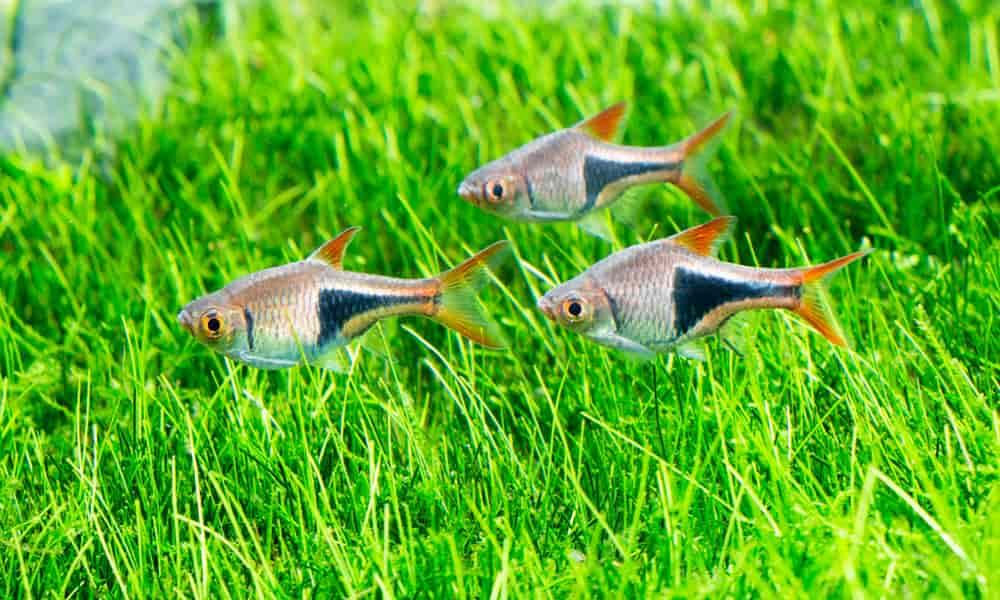
The Harlequin Rasboras is a popular choice among the peaceful, freshwater fish community folks, as it is incredibly lively and vibrant in appearance with a reddish copper hue.
Harlequin Rasboras are easy to care for and enjoy swimming in schools of their own kind but certainly get on well with other peaceful, community fish.
The Harlequin Rasbora prefers a fish tank that has dim lighting, lots of room for swimming, and ample vegetation to nibble on.
- Length: Up to 1.75 inches
- Lifespan: Up to 6 years
- Water temperature: 74-78°F
- Care level: Moderate
- Temperament: Peaceful
- Diet: Omnivorous
- Ideal tank mates: Cardinal tetras, dwarf gouramis, small barbs, bettas, neon tetras, small barbs, danios, cory catfish
- Breeding: Egg layer
German Blue Ramirezi Cichlid

This beautiful species, otherwise known as the German Blue Ram, can be labeled as difficult to keep – however, this is mainly because they’re extra sensitive to the quality of the water.
Besides this, they are a peaceful and beautiful community fish.
The right lighting shows off the stunning multicolored styling of the German Blue Ram with various shades of red, gold, and blue with a neon iridescence, black spotting, and a black stripe running through its eye.
- Length: 2-3 inches
- Lifespan: 2-3 years
- Water temperature: 78-85 ºF
- Care level: Moderate
- Temperament: Peaceful
- Diet: Omnivorous
- Ideal tank mates: Discus, Cardinal Tetra, Rummynose Tetra, Kuhli Loaches and Clown Loaches.
- Breeding: Egg layer
Betta Splendens (Siamese Fighting Fish)
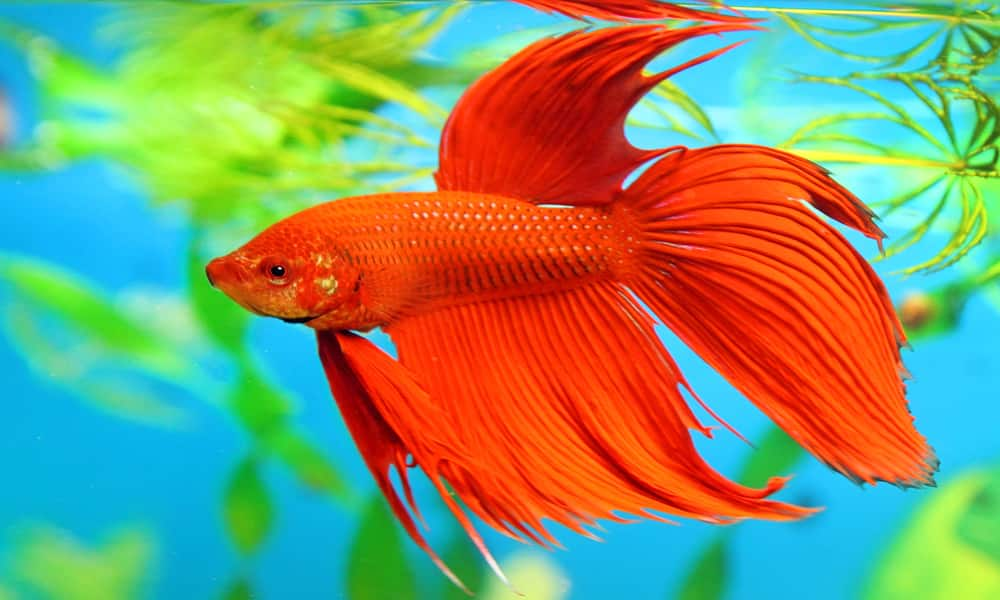
Although this popular pet store shelf fish is not generally seen as a community fish, that is a huge misconception. Siamese Fighting Fish are separated into tiny bowls on pet store shelves, kept in individual containers.
Siamese Fight Fish are separated in this way because males cannot be kept in the same tank. Females certainly can be, though, so there’s really no need to separate all of them. But I digress. Male Betta Spelendens vary in bright colors with long, flowing fins.
Females are generally more muted and have much shorter fins, making them less popular than their male counterparts.
Contrary to popular belief, it is also not ideal to raise these fish in a bowl, as they prefer a heated tank with lots of room.
- Length: Up to 3 inches
- Lifespan: 2-3 years
- Water temperature: 75-86ºF
- Care level: Moderate
- Temperament: Peaceful
- Diet: Omnivorous
- Ideal tank mates: Females can live with any other peaceful community fish. This is also true for males except for any fish that has a similar body types and long fins that they may mistake as another male betta.
- Breeding: Egg layer
Black Molly
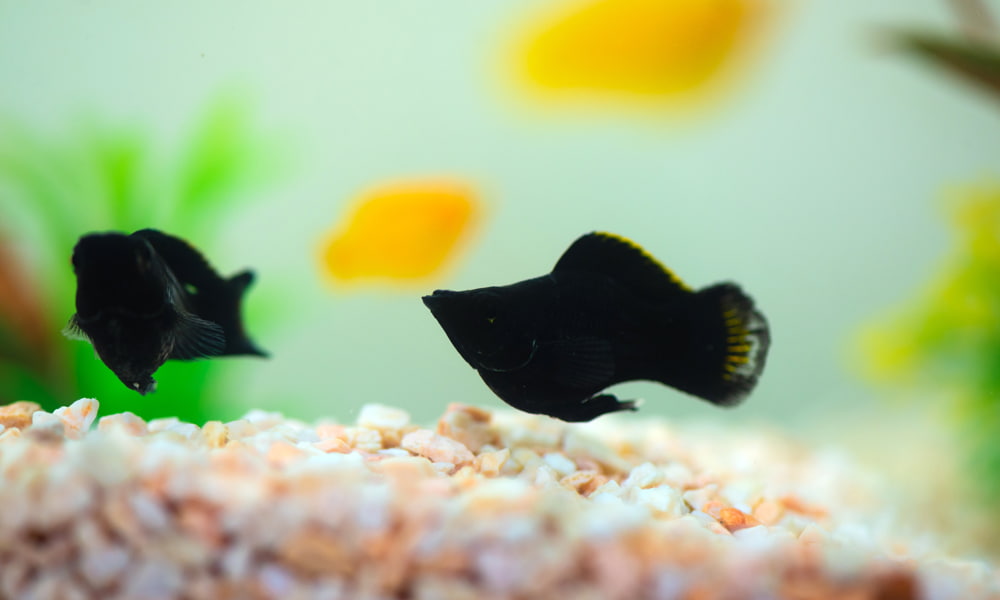
The Black Molly is one of the most popular beginner fish out there. Although they are not a colorful aquarium fish, their rich black color and distinctive characteristics make them an attractive addition to any fish tank.
An interesting fact about the Black Molly is that their dark color comes from a skin condition.
There is actually no pigmentation in their skin. Having said this, you will still find Black Mollies with yellow streaks running down the dorsal fin and flanks containing a slight silver tinge.
- Length: Up to 3 inches
- Lifespan: 2-3 years
- Water temperature: 75-86ºF
- Care level: Moderate
- Temperament: Peaceful
- Diet: Omnivorous
- Ideal tank mates: Female can live with any other peaceful community fish. This is also true for males except for any fish that has a similar body type and long fins that may be mistaken for a Male black Molly.
- Breeding: Egg layer
Guppy
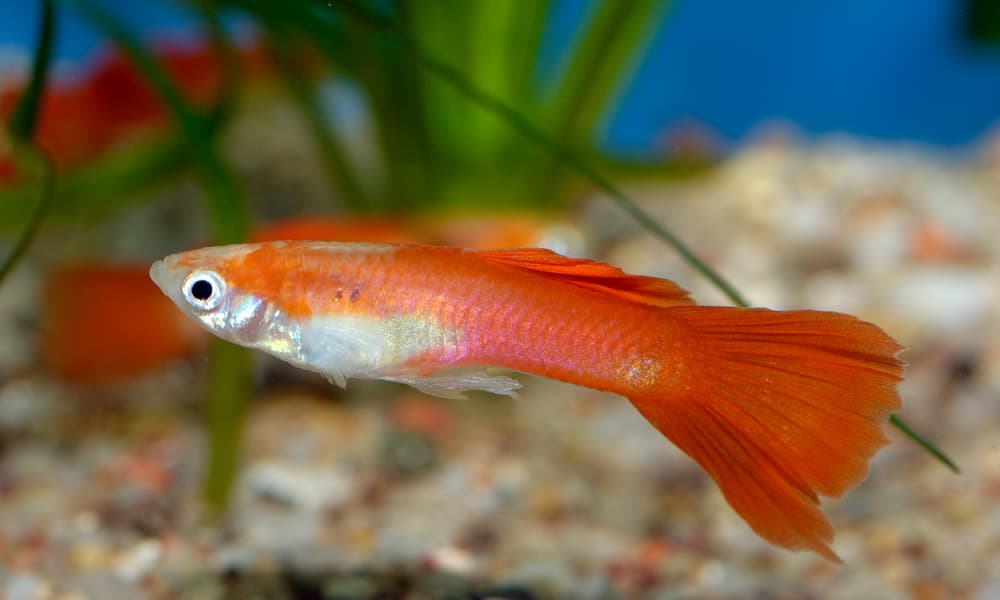
The Guppy is one of the world’s most widely distributed freshwater fish and a top contender for most popular community species. It’s an incredibly adaptable fish which is one of the main reasons why it’s so popular in a community tank.
An interesting fact about Guppies is that, in the wild, males are more colorful than females for the purposes of breeding. Male Guppies use their flashy, multicolored spots and stripes to attract females.
The body of the female Guppy is generally pale grey or silver.
- Length: Up to 2.4 inches
- Lifespan: 1-3 years
- Water temperature: 74-82ºF
- Care level: Easy
- Temperament: Peaceful
- Diet: Omnivorous
- Ideal tank mates: Glassfish, Cardinal Tetra, Corydoras Catfish, Molly, Pleco
- Breeding: Livebearer
Bolivian Ram
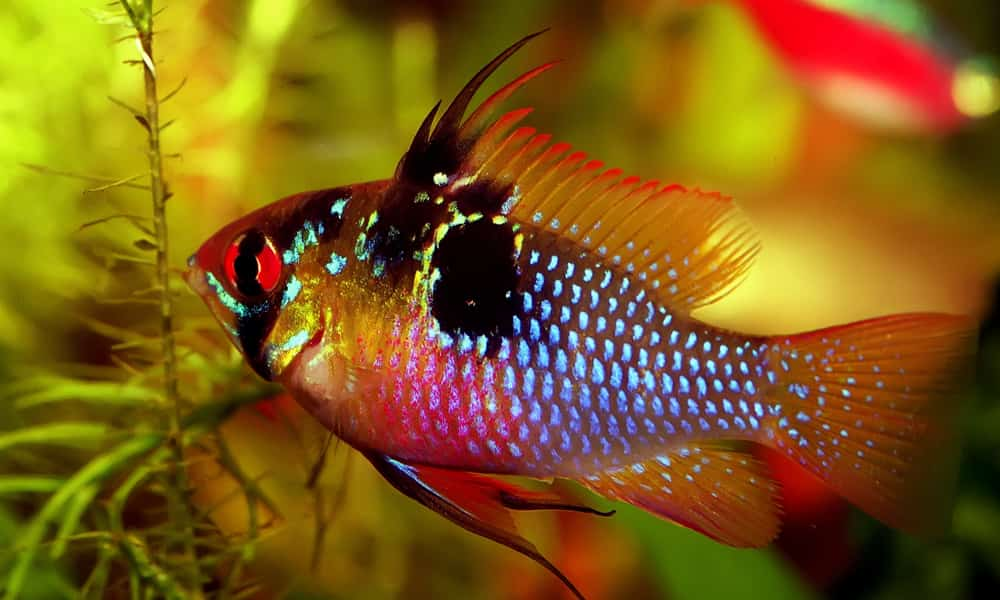
The Bolivian Ram is a superb choice when it comes to adding a peaceful, colorful fish with a ton of personality to your community tank.
It belongs to the Cichlidae family and is also known as the Butterfly Ram, Bolivian Butterfly Cichlid, and Ruby Cichlid.
As mentioned, certain Cichlids tend to get a bad rep when it comes to whether or not they’re easy to keep. They certainly have some closely related cousins, such as the Green Terror Cichlid, that are not for beginners.
That said, the Bolivian Ram is an excellent beginner and community fish and striking in appearance. Body colors range from a dull brown to a grayish-blue and they have yellow bellies with a distinctive black spot in the middle.
They sometimes have a black line between their eyes and have orange edges on their fins and tails.
- Length: Up to 3.5 inches
- Lifespan: Up to 4 years
- Water temperature: 73.4-82.4ºF
- Care level: Easy
- Temperament: Peaceful
- Diet: Omnivorous
- Ideal tank mates: Guppies, Platies, Silver Dollars, Dwarf Gouramis, Rummy Nose or Emperor Tetras, Corydoras Catfish, Plecostomus
- Breeding: Egg layer
Pearl Gourami
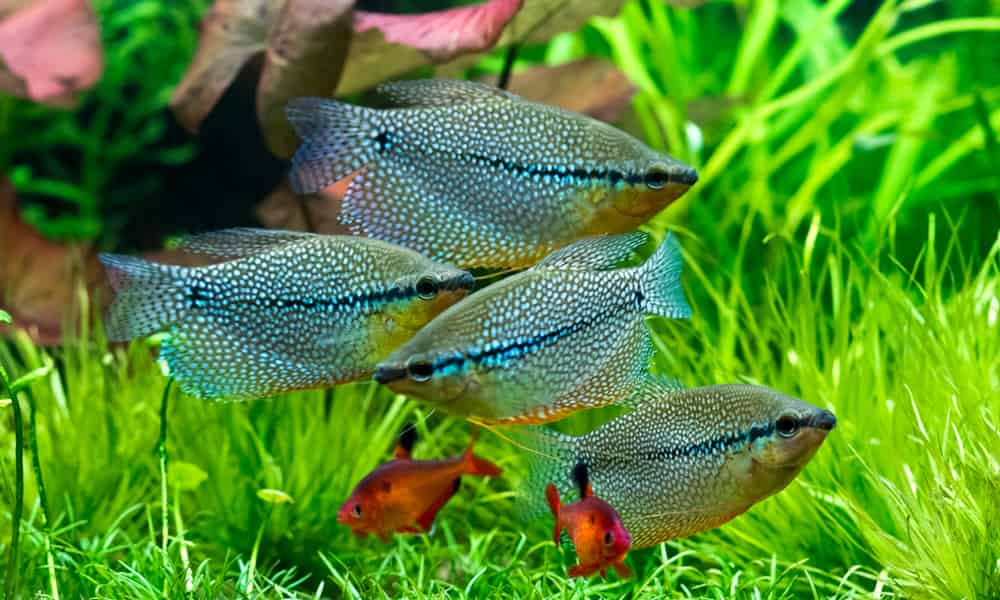
The Pearl Gourami, also known as the Leeri or Lace Gourami, is attractive, hardy, and possibly the easiest-to-keep Gourami out there.
It is integral to their health and well-being that they are kept with other peaceful, non-aggressive fish. An interesting fact about the Pearl Gourami is that they are considered a Labyrinth Fish, which means they can breathe directly from the air and so need regular access to the surface of the tank.
Appearance-wise, the Pearl Gourami is stunning with an iridescent pearl body with brown flecks and a horizontal black line running from the lips to the tail.
The Pearl Gourami has long and thin ventral fins that give it the look of feelers.
- Length: Up to 4 inches
- Lifespan: 3-5 years
- Water temperature: 75-86ºF
- Care level: Easy
- Temperament: Peaceful
- Diet: Omnivorous
- Ideal tank mates: Dwarf Cichlids, Small Tetras, Danios, Guppies, Platies, Swordtails
- Breeding: Egg layer
Rainbowfish

Where would this list of the best freshwater aquarium fish combination be without mentioning the stunningly beautiful Rainbowfish?
Rainbowfish are an extremely peaceful, multicolored fish native to Papua New Guinea, Indonesia, and Australia. They are also very active, making them even more interesting to watch swimming around in your freshwater tank.
Their fins appear multicolored and change shades in different light settings while their bodies are generally red, blue, yellow, silver, and black.
A Rainbowfish should be kept in a large aquarium with plenty of open space for them to swim around. They also enjoy heavy plant growth that replicates their natural habitat so make sure you have plenty of greenery in your tank.
- Length: Up to 4.5 inches
- Lifespan: 5-8 years
- Water temperature: 74-78ºF
- Care level: Easy
- Temperament: Peaceful
- Diet: Omnivorous
- Ideal tank mates: Larger Tetras, Rasboras, Catfish, other non-aggressive Cichlids
- Breeding: Egg layer
Conclusion
When it comes to selecting the inhabitants of your community freshwater aquarium, it’s important to pay extra attention to the fish that you are choosing.
Do not randomly select a fish because you like the way it looks – it may not play well with others!
There is plenty of selection available when it comes to peaceful community fish that are also incredibly aesthetically pleasing.
A freshwater aquarium instantly fills your space with tropical-looking life and provides stress release and quiet, constant companionship. With a little research, you can choose the best freshwater aquarium fish combination that’s right for you and your home.
